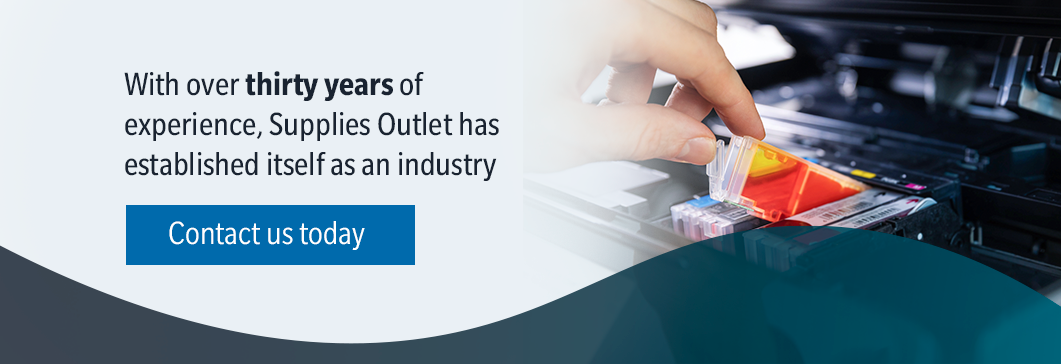Regardless of the many technological advances and digitization efforts that have emerged in the past few years, printing documents on paper is still a widely-used method for communication and record-keeping — in both personal and professional environments. While paper usage remains important to many people on a personal level, as well as for business reasons, the negative environmental effects of printing on paper is a reality that we all must grapple with.
While clean paper itself is relatively easy to reuse, upcycle and eventually recycle, many of us may feel more confused and uncertain as to how we can dispose of printer cartridges in the most sustainable and eco-conscious ways possible. In most cases, printer cartridges can, in fact, be recycled. Recycling printer cartridges simply takes a bit of background information and know-how. Accessing a recycling site that is suitable for printer cartridges may be easier for some than others, depending on where you live.
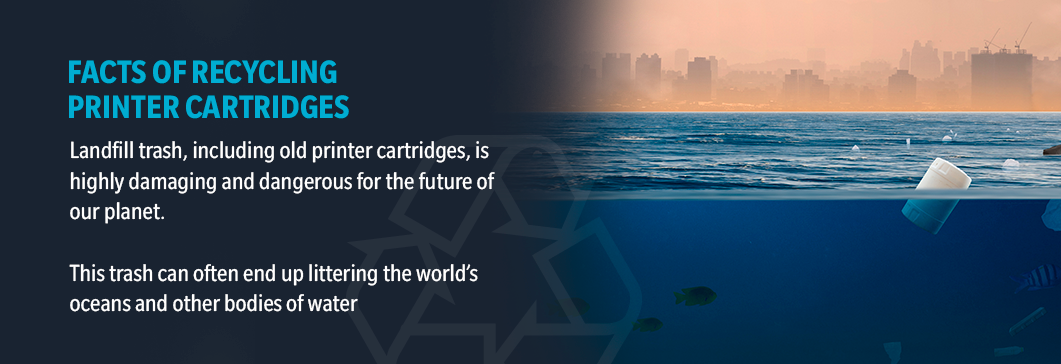
Understanding The Facts Of Recycling Printer Cartridges
Some studies have indicated that as many as 70% of printer cartridges end up in landfills. That amounts to about 350 million used printer cartridges going into landfills around the world each year. This is a staggering statistic, and does not bode well for the future of our planet and human stewardship of the natural world.
Landfill trash, including old printer cartridges, is highly damaging and dangerous for the future of our planet. This trash can often end up littering the world’s oceans and other bodies of water — which in turn can disrupt the living organisms and ecosystems that are responsible for so many of the habitable climates on our earth. While it is always quite easy to throw a printer cartridge into the trash once it is empty, keep in mind that every piece of plastic that has ever been created still exists on the earth. It takes over one thousand years for a single printer cartridge to decompose in a landfill. As such, upcycling and recycling these plastic items is truly imperative. There is no such place as “away” — when you throw something “away”, it has to go somewhere.
While recycling printer cartridges takes a bit more effort than conventional landfill disposal, there are many benefits to choosing this option.
How Printer Cartridges Are Recycled
The method of recycling printer cartridges can vary from recycling facility to recycling facility. Luckily, the actions that you need to take, as the average consumer, are relatively simple, easy, and (in most cases) cost-free. Depending on where you live, the process for recycling printer cartridges in your area may be different from the steps outlined in this post. You can check in with local political, civic and environmental leaders in your area to learn more about sustainability and recycling efforts in and around your community.
However, the following steps are a good basic outline and explainer for how old printer cartridges are recycled, and the role that you, the consumer, plays in the process.
- Collecting the items. It may be obvious, but in order for plastic printer cartridges to be recycled, you, the consumer, must properly dispose of them. The options for disposing to-be recycled items, including printer cartridges, will vary from location to location. In general, there are a few common ways in which you can put your used cartridges on the path to being recycled.
If you and your household recycle other common items, such as plain paper, aluminum cans, cardboards and plastic bottles, you may already be familiar with your nearest local recycling plant. Depending on where you live, you may be responsible for taking in and recycling your items yourself. In some places, waste management services may pick up your recycling along with your landfill trash when they stop by your home.
However, take care not to mix in your used printer cartridges with your other to-be recycled products. In most cases, printer cartridges require a separate collection process. Again, the exact method for this can vary depending on the location in which you live. Some communities may have designated printer cartridge collection points — which may or may not be located within a general recycling plant. If you work in an office, your company may collect used cartridges themselves. In most places throughout America, retail storefronts for select businesses, including some Staples and Office Depot locations, accept toner and ink cartridges for recycling. You can call local stores in your area to learn more about their specific recycling programs.
- Sorting the items. Once printer cartridges have been collected, recycling facilities will begin the process of sorting through them and determining what pieces are viable for successful recycling. Recycling facilities rely on machinery specifically designed for effectively sorting different material for the recycling process. Called “green machines,” recycling machinery is crucial to the entire process and is highly important to ensuring that recycling is as effective as possible.
You may not realize this from first look at an ink and/or toner cartridge, but these items are composed of several different types of materials. Clean and contaminated plastic pieces, aluminium, steel, other metals and ink can all be found within the most common types of printer cartridges. It’s nearly impossible that every single part of the cartridge will actually be able to be recycled into something new. Still, the pieces that can be recycled will find new life in a new product, and thus prolong their lives outside of a landfill.
- Processing & repurposing the items. Now that you have a basic understanding of the different components that make up printer cartridges, we can look closer at how these various parts and materials can be recycled and repurposed into new and different products.
Metal components, such as steel and aluminium, can be harvested from old cartridges and recycling into functional parts. Most commonly, these recycled metal pieces can be used to create common household appliances, such as dishwashers and laundry machines. Aluminium is most commonly used in the manufacturing of cans and tins for food and beverage items.
Cartridge plastic that has been contaminated by toner or ink cannot be effectively recycled. Contrary to what you might think, these contaminated plastic pieces can, in fact, be reused. Most commonly, contaminated plastics can be ground down and reused as synthetic building materials for furniture, fencing and other building materials. Most cartridges also contain clean plastics that can be recycled into a number of everyday products, such as ballpoint pens. Residual ink, in some cases, can even be recaptured and used to fill up these recycled-material pens.
Recycling green machines can sometimes recover residual toner from old cartridges as well. This leftover toner can be blended with asphalt, plastic and glass pieces to create paving materials for smooth, high-quality roadways.
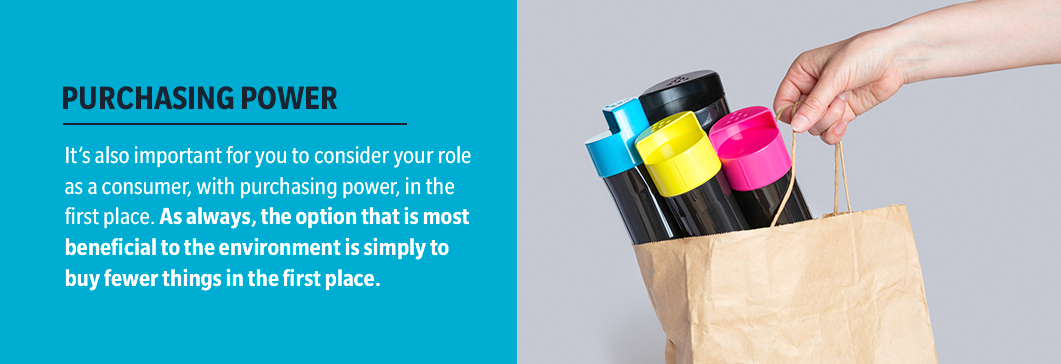
- Buying post-consumer recycled products. As a consumer, you are responsible for ensuring that your old printer cartridges and other recyclable items are collected by the appropriate recycling facilities. However, that is not the only role that you play in the recycling process. It’s also important for you to consider your role as a consumer, with purchasing power, in the first place. As always, the option that is most beneficial to the environment is simply to buy fewer things in the first place.
Of course, in many cases, buying certain products is a necessity. Ink and toner cartridges often fall into the “necessities” category, especially for companies and business owners. When possible, try to seek out and buy products that are made from post-consumer recycled (PCR) materials. By purchasing PCR products, you use your power as a consumer to communicate to businesses that these types of products are in-demand.
The Benefits Of Recycling Printer Cartridges
If you rely on ink and toner cartridges — whether in a personal and/or professional capacity — it will behoove you to recycle these cartridges regularly and consistently, and for a variety of reasons. As is true with nearly every type of product that can be recycled, the benefits of recycling can greatly outweigh the slight inconvenience of collecting and depositing the items. Getting rid of printer cartridges via recycling rather than landfill disposal can have positive effects in a myriad of ways. These positive effects can include environmental protection, waste reduction and cost savings.
- Environmental protection. Perhaps the most obvious benefit of recycling cartridges — or recycling anything, really — is the way in which it can protect the environment and increase sustainability in the creation of metal- and plastic-based products. Recycling your printer cartridges saves energy (compared to the production of brand-new cartridges), and consequently, can reduce both water and air pollution. As such, recycling your old cartridges can be a relatively simple and low-stress way for you and your company to reduce your carbon footprint, and, in turn, reduce your impact on the environment and its limited resources.
- Waste reduction. Another rather obvious benefit of recycling is the ways in which it can reduce — at least temporarily — disposal into landfill trash. Ink and toner cartridges can be recycled in ways that recover, and in many cases, reuse the ink and toner residuals themselves. Keep in mind that, even before you recycle your printer cartridges, you may be able to refill them. Some types of cartridges can actually be refilled. Brands including HP, Canon, Brother, Epsom and others offer refillable cartridge options. To get the greatest possible waste reduction benefit from your cartridges, use refillable types for as long as you can, before eventually recycling them.
- Economic considerations. The economic benefits of recycling may not be as immediately apparent as some of the other positive aspects of the practice. In fact, recycling can save your local community significant amounts of money, as recycled waste products typically cost much less to handle than traditional landfill waste. In addition, effective and consistent recycling can help both your local area, and the country as a whole, to reduce its carbon footprint and overall emissions. In addition, some cartridge recycling programs will even pay you small amounts to send in your old cartridges — not dissimilar to aluminum can buy-back initiatives.
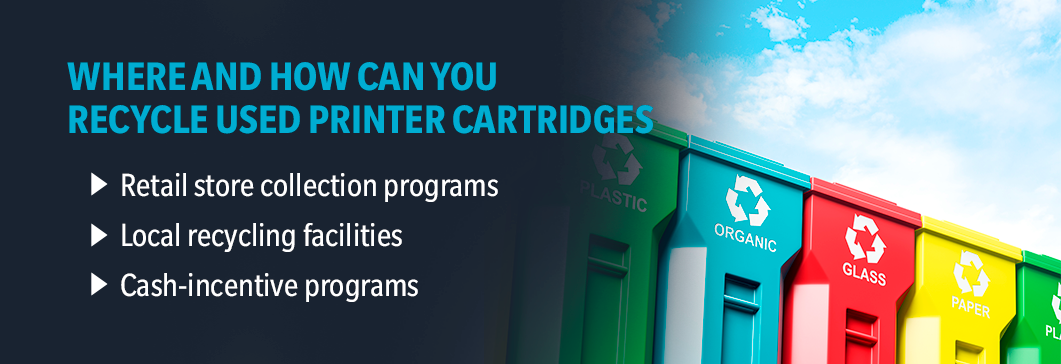
Where and How Can You Recycle Used Printer Cartridges?
The average consumer will have a few basic options when it comes to recycling, and in some cases, resuing, their ink and toner printer cartridges. These options include, but are not limited to, the following:
- Retail store collection programs. Many popular office supply stores offer cartridge recycling collection as a service to their customers. These include some locations of Staples, Office Depot, Office Max and others. Call around to local office stores in your area to find out what options are available to you. This can often be one of the easiest and most convenient options — especially for small business owners, who will likely stop by and shop at these stores anyway. Simply bring in your empty cartridges and deposit them at the store.
- Local recycling facilities. Printer cartridges cannot be recycled in common “single-stream” collection programs. As such, take care to keep your used cartridges separate from other items that you may recycle. Some local recycling facilities will take your cartridges, though not all. You can check in with your local recycling plant, and/or local civic leaders in your area to find out what options are available to you, in your local area and community. Collect your used cartridges separately from your other recyclables and drop them off at the facility.
- Cash-incentive programs. Similar to the aluminum can and plastic bottle buy-back programs of old, recently some similar offerings have emerged to address the issue of printer cartridge recycling. One of the most popular of these programs includes Evolve Recycling. Evolve will pay consumers cash money to send in their used cartridges with a prepaid shipping label. Exact prices will vary depending on the volume and brands of cartridges that you send in. Some people use the proceeds from these cash-incentive programs to support nonprofit work and other fundraising efforts.
Once you’ve collected enough cartridges to fill a box, simply register your donation with the cash-incentive program of your choice. Print out the shipping label and drop your package in the mail. Then, simply sit back and wait for your money to arrive!
- Refillable cartridges. When it comes to printer cartridges, one of the most sustainable options is to choose refillable cartridges from the outset. Most major cartridge manufacturers offer refillable options. While refillable cartridges can extend the life of your ink and toner parts, eventually you will need to replace the whole cartridge. When that time comes, recycling your cartridges will even further reduce your carbon footprint and plastic waste creation.
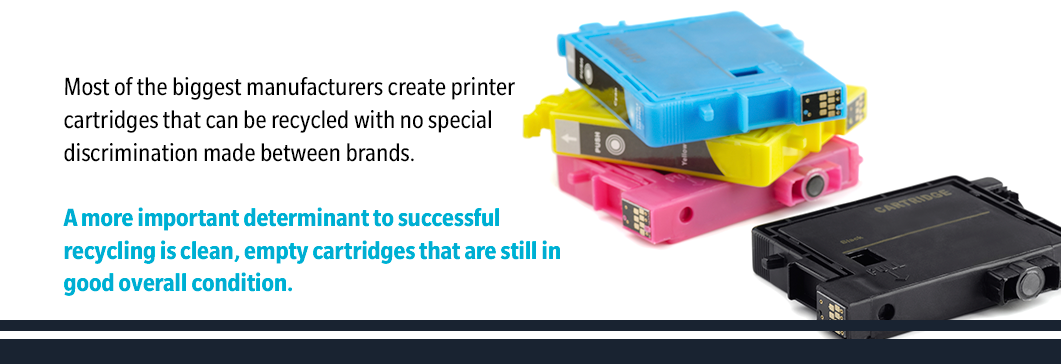
Printer Cartridge Recycling: Frequently Asked Questions
- Q: Can printer cartridges be recycled?
A: The simple answer is yes! Nearly all types of printer cartridges can be recycled — this includes both toner and ink cartridges. However, keep in mind that printer cartridges cannot be recycled when they are mixed in with other recyclables (such as cardboard, paper, aluminium cans, etc). You will need to seek out a cartridge-specific program in order to recycle them correctly.
- Q: Do different brands of printer cartridges have different recycling needs?
A: The simple answer to this question is no. Most of the biggest manufacturers, including HP, Epson, Brother, Canon and others, create printer cartridges that can be recycled with no special discrimination made between brands. A more important determinant to successful recycling (rather than brand) is clean, empty cartridges that are still in good overall condition.
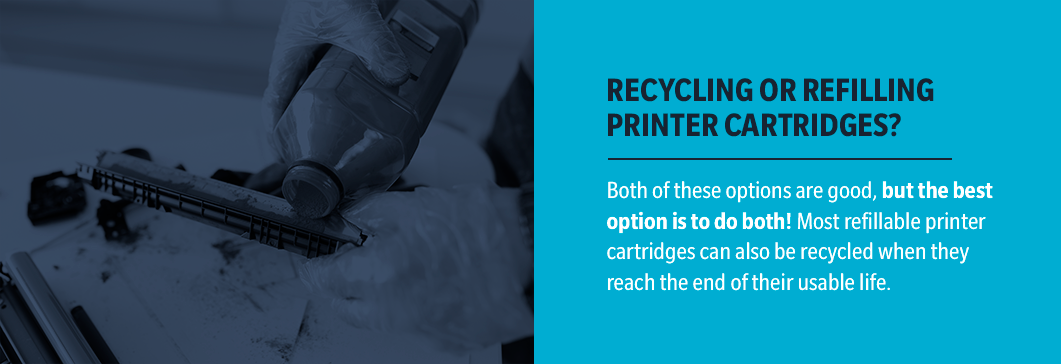
- Q: Which is better: recycling or refilling printer cartridges?
A: Both of these options are good, but the best option is to do both! Most refillable printer cartridges can also be recycled when they reach the end of their usable life. At that stage, you can recycle the refillable cartridge(s) along with any other cartridges that you may have. As such, there is no reason to choose between refilling and recycling. You can do both and feel proud to reduce your waste in the most impactful way possible.
- Q: How many times can I refill a cartridge?
A: On average, most refillable cartridges can only be refilled about three to five times before they need to be replaced. This number, of course, can vary based on the amount of printing that has been done with the cartridge and the quality of the cartridge from the outset.
- Q: What do I have to do to recycle my printer cartridges?
A: Luckily, as the consumer, you really don’t have to do anything particularly difficult or time-consuming in order to recycle printer cartridges. Essentially, you will just have to do two things. First, designate a box or bin for collecting up used cartridges. Once your receptacle is full, either drop it off at a store or recycling facility (that offers a cartridge recycling program), or pack up and mail the cartridges to a cash-incentive program. That’s it!
- Q: Why should I bother recycling? What are the benefits?
A: Recycling can have considerable benefits, both environmental and economically. Given the very minimal amount of work that recycling takes on your end, the benefits greatly outweigh the effort. Recycling can help to reduce waste, energy consumption and pollution. And, if you choose to participate in a cash-incentive recycling program, it can even make you money.
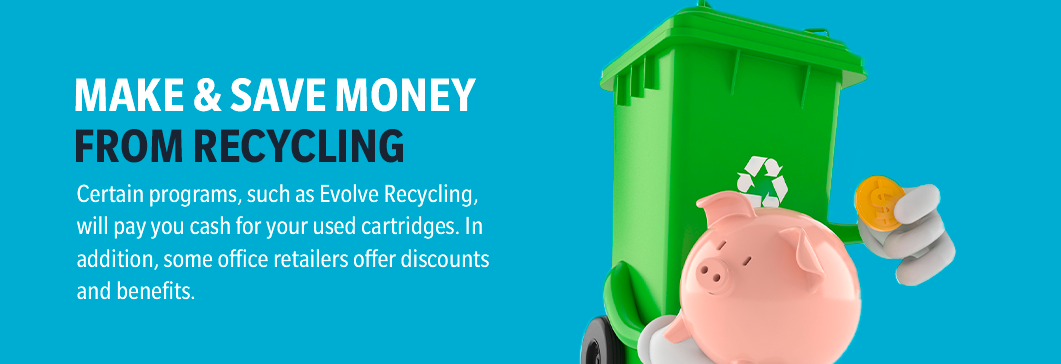
- Q: Can I make money from recycling my printer cartridges?
A: Yes! Certain programs, such as Evolve Recycling, will pay you cash for your used cartridges. In addition, some office retailers offer discounts and benefits to customers who utilize their recycling services. Both Office Depot and Staples offer saving rewards to customers, based on participation in their recycling efforts.
- Q: Do ink and toner manufacturers offer recycling programs?
A: The simplest answer is, yes, in some cases. HP is particularly well-known for their recycling efforts. Customers can return their used HP cartridges to HP directly using the mail-in program. Many manufacturers also partner with retailers like Staples, Office Depot, Walmart and others to ensure robust cartridge recycling programs.
Learn More About Supplies Outlet Today!
Supplies Outlet is an online retailer that specializes in selling compatible and remanufactured printer cartridges. Their fully online model is highly appealing to both individuals and business owners, as it prioritizes excellent customer service, quality products, competitive pricing, and comprehensive product offerings.
With over thirty years of experience, Supplies Outlet has established itself as an industry leader, with proven expertise and world-class customer service. All of Supplies Outlet’s products are covered by a sixty-day money-back guarantee, along with a hassle-free, one-year warranty.
Supplies Outlet is proud to offer printer cartridges that are compatible with all of the major manufacturers — including HP, Dell, Canon and Brother, among others. In addition to compatible and remanufactured printer cartridges, Supplies Outlet also offers select paper products and other general office supplies.
By utilizing an online retailer, you can save considerable time, stress and money, when compared to shopping at traditional brick-and-mortar stores. Supplies Outlet’s website is simple and user-friendly, which makes it a wonderful option that nearly anyone can use effectively.
Supplies Outlet prides itself on excellent service and customer satisfaction. New Supplies Outlet customers can feel confident in their comprehensive product offerings and services, given its thirty-year track record and thousands of fulfilled orders. Contact Supplies Outlet today, and customer service professionals will be happy to assist you in every way that they can.

 Log in
Log in




